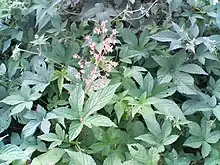葎
| ||||||||
Translingual
Han character
葎 (Kangxi radical 140, 艸+9, 12 strokes, cangjie input 廿竹人手 (THOQ), four-corner 44257, composition ⿱艹律)
References
- Kangxi Dictionary: page 1044, character 13
- Dai Kanwa Jiten: character 31397
- Dae Jaweon: page 1505, character 9
- Hanyu Da Zidian (first edition): volume 5, page 3252, character 4
- Unihan data for U+844E
Chinese
| trad. | 葎 | |
|---|---|---|
| simp. # | 葎 | |
Glyph origin
Pronunciation
Definitions
葎
- This term needs a translation to English. Please help out and add a translation, then remove the text
{{rfdef}}.
Japanese
Readings
Etymology 1
 |
 |
 |
 |
| Kanji in this term |
|---|
| 葎 |
| むぐら Hyōgaiji |
| kun’yomi |
From Old Japanese.[1] Probably the eastern Japanese form. Compare the alternation in ugura and mugura readings in the etymology of 土竜.
May ultimately derive from obsolete verb 剥る (mukuru, “to peel off, to tear off”), perhaps related to the way that weeds are often removed by tearing the plant out.
Noun
葎 • (mugura)
- any of various plants of order Gentianales or Urticales, that form thickets, often have thorns and form vines, and prefer wet or disturbed soils; generally regarded as weeds
- , text here:
- 牟具良波布 / 伊也之伎屋戸母 / 大皇之 / 座牟等知者 / 玉之可麻思乎
- 葎延ふ / 賎しき宿も / 大君の / 座さむと知らば / 玉敷かましを
- むぐら はふ / いやしき やど も / おほきみ の / まさむ と しらば / たま しかまし を
- Mugura hafu / iyashiki yado mo / ohokimi no / masamu to shiraba / tama shikamashi wo
- Even a shabby house surrounded by weed thickets would be as if strewn with jewels if I knew you were there
- , text here:
Usage notes
The plants called by this name are many and varied, and include plants such as madder, cleaver, and hops.
The reading mugura appears to be the most common.
As with many terms that name organisms, this term is often spelled in katakana, especially in biological contexts (where katakana is customary), as ムグラ.
Derived terms
- 葎が門 (mugura ga kado): a gate overgrown with viny weeds
- 葎の門 (mugura no kado): a gate overgrown with viny weeds
- 葎の宿 (mugura no yado): a house overgrown with viny weeds
- 葎生 (mugurafu): a dense growth of viny weeds
- 大双葉葎 (ōfutaba mugura): literally “big twin-leaf mugura”, Diodella teres or poorjoe
- 金葎 (kana mugura), 葎草 (kana mugura): literally “money mugura”, Humulus japonicus, Humulus scandens: the Japanese hop plant
- 磯馴葎 (sonare mugura): literally “pebble-accustomed mugura”, Hedyotis biflora var. parvifolia
- 刺無葎 (togenashi mugura): literally “thornless mugura”, Galium mollugo, false baby's breath or hedge bedstraw
- 花八重葎 (hana yae mugura): literally “flowering eight-layer mugura”, Sherardia arvensis or field madder
- 双葉葎 (futaba mugura): literally “twin-leaf mugura”, Hedyotis diffusa
- 八重葎 (yae mugura): literally “eight-layer mugura”, Galium spurium (false cleaver or Marin County bedstraw)
- 四葉葎 (yotsuba mugura): literally “four-leaf mugura”, Galium trachyspermum
Etymology 2
| Kanji in this term |
|---|
| 葎 |
| うぐら Hyōgaiji |
| kun’yomi |
From Old Japanese. Probably the western Japanese form. Compare the alternation in ugura and mugura readings in the etymology of 土竜.
Noun
葎 • (ugura)
Etymology 3
| Kanji in this term |
|---|
| 葎 |
| もぐら Hyōgaiji |
| kun’yomi |
Probably an alteration or dialectal variant of mugura above. Appears with this reading in the 本草和名 (Honzō Wamyō, “Japanese Names of the Real Herbs”), a pharmacopoeia written in 923.[1] Still listed as an alternate reading in modern dictionaries.[1][2]
Noun
葎 • (mogura)
References
- Shōgaku Tosho (1988) 国語大辞典(新装版) [Unabridged Dictionary of Japanese (Revised Edition)] (in Japanese), Tōkyō: Shogakukan, →ISBN
- Matsumura, Akira, editor (2006), 大辞林 [Daijirin] (in Japanese), Third edition, Tōkyō: Sanseidō, →ISBN
- Fukane no Sukehito (c. 901–923) Maruyama Yumiko, Wu Qian, editors, Honzō Wamyō: Eiin, Honkoku to Kenkyū) (in Japanese), Kyūko Shoin, published 2021, →ISBN.